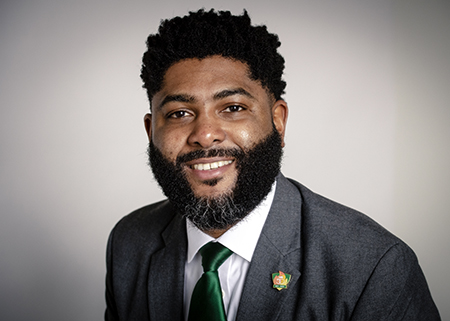Media contact: Alicia Rohan
 Think back to your last meeting — was it safe? Not physically, mind you, but emotionally, psychologically. How about your work team? Anthony Hood, Ph.D., an associate professor of management in the University of Alabama at Birmingham Collat School of Business, focuses his research on team dynamics, especially in the psychological safety realm of a team.
Think back to your last meeting — was it safe? Not physically, mind you, but emotionally, psychologically. How about your work team? Anthony Hood, Ph.D., an associate professor of management in the University of Alabama at Birmingham Collat School of Business, focuses his research on team dynamics, especially in the psychological safety realm of a team.
Hood recommends employees consider these questions in evaluating how psychologically safe, a shared measure of safety for a team to express interpersonal risk-taking, they feel at work:
- If you make a mistake on your team, is it held against you?
- Are you able to bring up problems and tough issues?
- Do people on the team sometimes reject others for being different?
- Is it safe to take a risk?
- Is it difficult to ask other team members for help?
- Do people on the team deliberately act to undermine your efforts?
- Are your unique skills and talents valued and utilized?
In a landmark 1999 study, Harvard researcher Amy Edmondson, Ph.D., used a similar set of questions to measure something she called team psychological safety — “a shared belief held by members of a team that the team is safe for interpersonal risk-taking,” as she wrote in the introduction to her paper.
Welcome to the jungle
Whether you think of your workplace as a jungle or a second home, your work life is all about estimating risk. “Humans are hard-wired to recognize threats and govern ourselves accordingly,” Hood said. “We have a hyper-vigilance to threat. It’s our fight-or-flight response.”
Human instinct is to protect yourself. So in every meeting, feelers are out. Are people listening when I present ideas — or is my voice ignored? How does the boss react when she gets bad news? Do I feel that I can admit to my co-workers that I don’t know how to do something — or will they use that against me?
The answers to these questions “make the difference between waking up every Monday morning excited to go to work or sick to your stomach that you have to spend yet another week working for and with those people,” Hood said. These answers also determine whether you are willing to take a risk to suggest a new way of doing things or a better process to get the job done in your office.
Psychological safety may sound as though it means nothing more than good vibes, but it is deadly serious. “Lack of psychological safety explains why airplanes run into the sides of mountains or patients get their right leg operated on when they came in for surgery on their left,” said Hood, who also is director of Civic Innovation in the Office of the President at UAB, leads workshops on building better teams. “When people are afraid to speak up, bad things happen.”
 Anthony Hood, Ph.D., Collat School of BusinessPsychological safety pays off
Anthony Hood, Ph.D., Collat School of BusinessPsychological safety pays off
Psychological safety, Hood explains to those groups, helps the bottom line. In a multi-year effort known as Project Aristotle, Google studied the behaviors of its most successful teams. The top factor in a successful team was not intelligence or creativity or whether members attended elite schools — it was how psychologically safe the team was.
“Researchers are finding that psychological safety may be the No. 1 aspect of successful teams, driving creativity and innovation,” Hood said. That is because, as work becomes more complex and resources get tighter, team success depends on effective distribution of the workload. If teams can divide up their work to take maximum advantage of each member’s skills, they can get more done.
But first, everyone has to admit they cannot do it all on their own. Team members have to engage in “potentially risky interpersonal behaviors, such as admitting information deficiencies, declaring expertise, justifying or defending expertise when challenged, and admitting lack of desire to accept responsibility for a particular expertise domain,” as Hood and his co-authors explained in a 2015 study on psychological safety, published in the Journal of Organizational Behavior.
So how can managers encourage their employees to open up to risk? It is not simply a matter of making everybody “think positive.” For that 2015 study, Hood and colleagues studied 668 information technology professionals assigned to 121 enterprise resource-planning software-implementation teams. Among the study’s key findings were that the extent to which a team’s environment is perceived to be psychologically safe is influenced by its members’ general disposition toward positivity (e.g., cheerful, energetic and optimistic) or negativity (e.g., fearful, anxious and angry). That has implications for supervisors in industries where the composition of their project teams are in a constant state of flux. But what if you have got a set team and want to make it safer?
Managers: How to get safe
Psychological safety is usually set from the top down, Hood says. When he presents to leaders, Hood shares several ways to make that happen.
1. Everybody makes mistakes — even me
“If you are unable or unwilling to be psychologically and emotionally vulnerable with your team, then there’s a good chance your people don’t feel psychologically safe with you,” Hood said. “Sometimes managers are resistant because they feel like the process makes them look weak, that people will walk all over them.”
To build psychological safety, managers have to be willing to be vulnerable first, to show employees that it is OK. They need to admit when they have made a mistake and show that they are human too. It is critical to create an environment where experimentation and learning from failure are celebrated rather than punished.
2. Watch your reactions
“Leaders need to be very mindful of how they react to mistakes,” Hood said.
If a leader flies off the handle when your team brings a problem, a message is sent that failure and experimentation are not acceptable. And when people get that message, they hide their errors.
 3. Listen as much as you speak
3. Listen as much as you speak
“Have an open-door policy,” Hood said. “Make sure you have a regular time when people can come and talk to you.”
Leaders in a more senior role should create skip-level meetings, in which front-line employees can talk directly about what they are experiencing without their immediate supervisor present.
4. Encourage people to ask for help
If employees ask for help and are subsequently treated as if they are incompetent or slackers, they will suffer in silence; but the workplace will suffer as well.
“Don’t wait for them to come to you, either,” Hood added. “Go ask them, do you need help? Are you good? Give them the benefit of the doubt.”
5. Clarity for everyone
Psychological safety is particularly important when teams work in situations that are literally life-and-death, such as health care and aviation, Hood says. The National Institutes of Health has developed Team STEPPS, a “team-based training platform” that focuses on a culture of safety, Hood said, including “making clear the roles and responsibilities with a pre-briefing beforehand and a debriefing afterward.”
6. Speak of the devil
In the business world, some teams will assign a person to play devil’s advocate. They say, “We don’t want to be prone to groupthink, so it’s your job to come up with the counterpoint to every decision we make or to think about how this could go wrong.”
“Ensuring there will be some intellectual friction boosts creativity and innovation by expanding the range of ideas and solutions available for complex decision-making and problem-solving,” Hood said.
Employees: How to get safe
If you are an employee in a psychologically unsafe environment, realize that you always have options.
 1. Plan ahead
1. Plan ahead
“The importance of ‘managing up’ cannot be overstated, especially if your manager has a reputation for being difficult or passive-aggressive,” Hood said. “It takes some political savvy when you are trying to drive change across levels of power, but it can be done.”
To start off, monitor the personality and moods of the leader and how they respond best to difficult conversations. Leaders are people too — and sometimes they are dealt a bad hand by those above them. Other times, they may be dealing with personal issues outside the workplace. Empathize with them and the unfortunate situations they may be facing.
2. Strictly business
“Never make it personal,” Hood said. He always builds his case using the organization’s structure and explicitly stated strategies.
“Also, draw on the manager’s own words,” Hood said. “You might say, ‘You’ve always told us we should’ — fill in the blank — ‘and to that end I recommend we …’ Focus on proposing solutions, rather than restating the obvious problems and constraints.’
3. Realize it is time to move on
“Working in a psychologically unsafe environment can be detrimental to your mental health and emotional well-being,” Hood said. A new $1.8 million grant from the American Medical Association to UAB and three other leading academic medical centers will study emotional exhaustion, depression and burnout among physicians, he points out — just one example of rising burnout in health care settings and other workplaces.
“If your supervisor or the organization still doesn’t get it, it may just be a bad fit,” Hood said. “Please know that you always have options. There is a shortage of talent everywhere. Make the courageous decision to seek opportunities elsewhere in the organization or the industry.” That can be difficult, especially when you are in a successful situation professionally, he says. “No one should be made to choose between their well-being and their career.”
 Safety never sleeps
Safety never sleeps
Whether you are a leader or a team member, everyone can help to create psychological safety, Hood adds. “When I’m scanning the room at a meeting, I can often see when people are feeling unsafe,” he said. “A person had the courage to speak up and no one responded to what they said, for example. When I see that, I try to jump in and say to that person, ‘Can you go back to what you were saying?’ Ensuring that our teammates’ voices are heard and their ideas are respected is the responsibility of all team members. That’s the process of creating safety.”
And the process never stops. Psychological safety is not something you can create and then move on, Hood says. “It can ebb and flow on a weekly basis. Trust can be destroyed in one act. It requires us all to be thoughtful and vigilant. The best way is to be proactive about it. If you give safety, you’ll get safety in return.”
Too safe?
That said, there are times when some members of a team may be too safe, Hood says. “Consider for instance the phenomenon in the startup environment commonly known as ‘bro culture.’ This environment can emerge when the founding team exclusively comprises men — particularly those from one racial or ethnic background,” he said.
Such environments may encourage racially insensitive jokes, sexually suggestive banter, workaholism, binge drinking and offensive office décor. Customs formed among the early founding team may be safe to them, but toxic and offensive to women and racial/ethnic minorities subsequently added to the team.
This is something Hood discusses with startup founders as an entrepreneur-in-residence for the Velocity Accelerator program in Birmingham’s Innovation Depot, where he is a mentor for the 2019 cohort.
“Psychological safety is a particularly tough challenge in small teams, especially when you’re in business with a best friend, parent, kid or spouse,” Hood said. “Sometimes if you’re too close to people, they take liberties with the relationship — forcing you have to manage both roles at the same time.”
These multiplex relationships, as Hood calls them, were the subject of a 2017 study he led that resulted in the paper “Conflicts with Friends,” which was named one of the top papers of the year by the Journal of Business and Psychology.
“That’s where my research is taking me next,” Hood said. “I’m thinking more about the dark sides of psychological safety — when one person’s safety makes another unsafe.”
The 2015 study on “Mediating effects of psychological safety in the relationship between team affectivity and transactive memory systems” was published in the Journal of Organizational Behavior by Hood; Daniel G. Bachrach, Ph.D., from the University of Alabama; Suzanne Zivunska, Ph.D., from California State University; and Elliot Bendoly, Ph.D., from The Ohio State University.